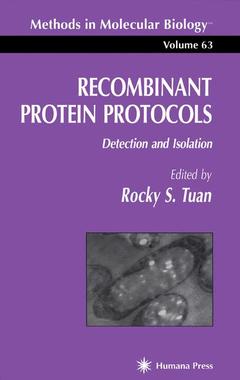Description
Recombinant Protein Protocols, 1997
Detection and Isolation
Methods in Molecular Biology Series, Vol. 63
Language: English
Subject for Recombinant Protein Protocols:
Publication date: 08-2013
448 p. · 15.2x22.9 cm · Paperback
448 p. · 15.2x22.9 cm · Paperback
Description
/li>Contents
/li>
A major success story of modem molecular biology is the development of technologies to clone and express specific genes. Current applications of recombinant gene products cover a wide spectrum, including gene therapy, production of bioactive pharmaceuticals, synthesis of novel biopolymers, agriculture and animal husbandry, and so on. Inherent in bringing these appli cations to fruition is the need to design "expression constructs" that will per mit the ready and specific detection and isolation of the defined recombinant gene products. Recombinant Protein Protocols grows out of the need for a laboratory manual on the detection and isolation of recombinantly expressed genes that covers both the background information and the practical laboratory recipes for these analyses. In this book, detailed and contemporary protocols are col lected to provide the reader with a wide-ranging number of methodologies to enhance the detection and isolation of their gene product(s) of interest. A large number of molecular tags and labels and their usage are described, including enzymes, ligand-binding moieties, immunodetectable molecules, as well as methods to detect interactive proteins, and gene expression-mediated alter ations in cellular activity. Chapters on in situ detection of gene expression deal with technologies that are currently being applied to the study of gene function and activity. Highlights of applications for recombinant gene expres sion technologies are provided to give readers exciting perspectives on the future of such technologies.
Overview of Experimental Strategies on the Detection and Isolation of Recombinant Proteins and Their Applications.- Detection and Isolation of Expressed Proteins.- Reporter Systems.- Detection of Recombinant Protein Based on Reporter Enzyme Activity: Chloramphenicol Acetyltransferase.- Human Placental Alkaline Phosphatase as a Marker for Gene Expression.- Use of Secreted Alkaline Phosphatase as a Reporter of Gene Expression in Mammalian Cells.- Detection of ?-Galactosidase and ?-Glucuronidase Using Chemiluminescent Reporter Gene Assays.- Chemiluminescent Immunoassay for the Detection of Chloramphenicol Acetyltransferase and Human Growth Hormone Reporter Proteins.- Detection and Selection of Cultured Cells Secreting Recombinant Product by Soft Agar Cloning and Antibody Overlay.- Detection and Isolation of Recombinant Protein Based on Binding Affinity Reporter.- Detection and Isolation of Recombinant Proteins Based on Binding Affinity of Reporter: Protein A.- Expression and Purification of Recombinant Streptavidin-Containing Chimeric Proteins.- Bacterial Expression, Purification, and Potential Use of His-Tagged GAL4 Fusion Proteins.- Detection of Expressed Recombinant Protein Based on Multidrug Resistance: P-Glycoprotein.- Detection and Isolation of Recombinant Proteins from Mammalian Cells by Immunoaffinity Chromatography: p53.- Yeast GAL4 Two-Hybrid System.- Alternative Yeast Two-Hybrid Systems.- Detection of Heterologous Gs-Coupled Receptor Activity in LLC-PK1 Cells Based on Expression of Urokinase-Type Plasminogen Activator.- Detection of Recombinant Gene Expression In Situ.- Histochemical and Fluorochrome-Based Detection of ?-Galactosidase.- Combined, Sequential In Situ Hybridization and Immunohistochemistry on the Same Tissue Section.- Whole Mount In SituHybridization to Embryos and Embryonic Tissues.- Whole-Mount In Situ Hybridization for Developing Chick Embryos Using Digoxygenin-Labeled RNA Probes.- Methods for Double Detection of Gene Expression.- In Situ PCR.- Expression and Detection of Green Fluorescent Protein (GFP).- Applications of Recombinant Gene Expression.- Transgenic Animals as Bioreactors for Expression of Recombinant Proteins.- Artificial Cells for Bioencapsulation of Cells and Genetically Engineered E. coli.- Hyperexpression of a Synthetic Protein-Based Polymer Gene.- Transplantation of Cells in an immunoisolation Device for Gene Therapy.- Delivery of Recombinant HIV-1-Directed Antisense and Ribozyme Genes.- Inducible System Designed for Future Gene Therapy.- Human Gene Therapy.
© 2024 LAVOISIER S.A.S.
These books may interest you

DNA VirusesMethods and Protocols 158.24 €


